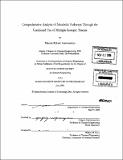Comprehensive analysis of metabolic pathways through the combined use of multiple isotopic tracers
Author(s)
Antoniewicz, Maciek Robert
DownloadFull printable version (20.85Mb)
Other Contributors
Massachusetts Institute of Technology. Dept. of Chemical Engineering.
Advisor
Gregory Stephanopoulos.
Terms of use
Metadata
Show full item recordAbstract
Metabolic Flux Analysis (MFA) has emerged as a tool of great significance for metabolic engineering and the analysis of human metabolic diseases. An important limitation of MFA, as carried out via stable isotope labeling and GC/MS measurements, is the large number of isotopomer equations that need to be solved. This restriction reduces the ability of MFA to fully utilize the power of multiple isotopic tracers in elucidating the physiology of complex biological networks. Here, we present a novel framework for modeling isotopic distributions that significantly reduces the number of system variables without any loss of information. The elementary metabolite units (EMU) framework is based on a highly efficient decomposition algorithm identifies the minimum amount of information needed to simulate isotopic labeling within a reaction network using knowledge of atomic transitions occurring in the network reactions. The developed computational and experimental methodologies were applied to two biological systems of major industrial and medical significance. First, we describe the analysis of metabolic fluxes in E. coli in a fed-batch fermentation for overproduction of 1,3-propanediol (PDO). (cont.) A dynamic 13C-labeling experiment was performed and nonstationary intracellular fluxes (with confidence intervals) were determined by fitting labeling patterns of 191 cellular amino acids and 8 external fluxes to a detailed network model of E. coli. We established for the first time detailed time profiles of in vivo fluxes. Flux results confirmed the genotype of the organism and provided further insight into the physiology of PDO overproduction in E. coli. Second, we describe the analysis of metabolic fluxes in the pathway of gluconeogenesis in cultured primary hepatocytes, i.e. isolated liver cells. We applied multiple 13C and 2H-labeled tracers and measured isotopomer distributions of glucose fragments. From this overdetermined data set we estimated net and exchange fluxes in the gluconeogenesis pathway. We identified limitations in current methods to estimate gluconeogenesis in vivo, and developed a novel [U-13C,2Hs]glycerol method that allows accurate analysis of gluconeogenesis fluxes independent of the assumption of isotopic steady-state and zonation of tracers. The developed methodologies have wide implications for in vivo studies of glucose metabolism in Type II diabetes, and other metabolic diseases.
Description
Thesis (Ph. D.)--Massachusetts Institute of Technology, Dept. of Chemical Engineering, 2006. Includes bibliographical references (p. 287-294).
Date issued
2006Department
Massachusetts Institute of Technology. Department of Chemical EngineeringPublisher
Massachusetts Institute of Technology
Keywords
Chemical Engineering.